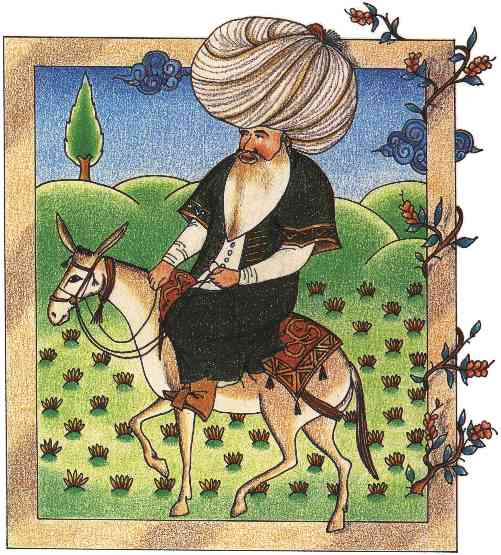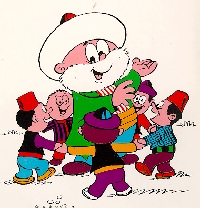| |
Wit, common sense, ingenuousness, ridicule...and the kind of humor that
reflects human psychology, exposes the shortcomings of a society,
criticizes even state and religious affairs yet always settles matters
amicably are the elements which together create a special kind of logic,
the Nasreddin Hodja logic. These features of the stories make the 13th
century character Nasreddin Hodja immortal. Therefore it is not an
exaggeration to consider him one of the main building blocks of folk
thought, and his humor, one of the best in the world.
Yet, it should be pointed out that these stories are related neither to
Nasreddin Hodja himself nor to his historical personality. In other
words, over the centuries many new stories where he was used as the main
character have emerged, enriching the collection we have today.
According to certain stories, Hodja was a contemporary of Tamerlane, who
invaded Anatolia at the beginning of the 15th century, and according to
the others, he lived either before or after the age of Tamerlane. Today,
we still do not have historical documents that relate Hodja's life and
his personality in depth.
The date 386 found inscribed on a grave stone attracted a lot of
attention. Considering his humor, the date was read backwards. The year
683 of the Islamic calendar corresponds to the years 1284-1285. Other
documents were used to support the theory that he died sometime in the
years 1284-1285. One of the most reliable document is the date1383 (796
in the Islamic calendar) found inscribed on the wall of his tomb in
Aksehir. It indicates that Hodja died before 1393 and his tomb had been
visited for years.
Our town, Sivrihisar; of the city of Eskisehir is accepted as the
birthplace of Hodja. A gravestone dated 1327 found in Sivrihisar,
belongs to his daughter Fatima and indicates that she lived 43 more
years after his death.
The oldest Nasreddin Hodja story is found in the book called
"Saltukname" written in 1480, which also contains other folk stories and
legends. It is stated in "Saltukname" that Hodja was born in
Sivrihisar and that the natives of Sivrihisar were famous for their
strange behavior and ingenousness.
The different behavior of the natives of Sivrihisar is also mentioned in a
handwritten story book in Biblioteque Nationale in Paris. These
documents are considered proof of his birth in Sivrihisar (and how funny
we can be:-))
Nasreddin Hodja miniature taken from a XVII th century hand written book
(Topkapi Palace Museum Library Cat. No. 2142).
Based on the above mentioned documents and certain stories, following is
the life story of Nasreddin Hodja:
He was born in the village of Hortu of Sivrihisar and died in 1284 in
Aksehir, a province of Konya, where his tomb is. His father was the
imam(religious leader) of the village. Nasr-ed-Din, or "Victory of the
Faith", was the name given by his parents to the author of the tales,
and Hodja, meaning "Master" or "Teacher" is the honorific title which he
subsequently acquired. He was sent at an early age to be taught the
essentials of Mohammedan religious and legal learning according to the
Hanafiya school in Konya. He qualified thus to be a schoolmaster and an
"Imam"; leader of public prayers in the Mosque, and he also became a
"Kadi"; magistrate dispensing Mohammedan Canon Law, which was in theory
the only law of the land, tempered though it might be frequently by
weightier considerations of a material order.
It is obvious that Hodja was a witty man with sense of humor and he was
a good conversationalist. Yet, based on most of the stories it is wrong
to assume that everything he said was humorous. Over the years, the
number of Nasreddin Hodja stories increased significantly since he was
used as the main character in the new stories about other people. Among
these, there are some that are easily recognized as not authentic
Nasreddin Hodja stories. We can, therefore, say that Hodja and his
stories were created by the natives of Anatolia in the 13th century, and
the creation has lasted for centuries. Today, these stories belong to
all Turkish people.
The themes of the stories cover not just the age when Nasreddin Hodja
lived but also the adventures of Turkish people over the centuries. As
one of our writers said"Nasreddin Hodja is the only person who lived
both before his birth and after his death. There are many historical and
social personalities who kept on living after their death but the only
person on earth who lived before his birth is Nasreddin Hodja".
Therefore, social life, the shortcomings of social life, differences
between the ruling class and the common people, famines, the thousand
faces of daily life, man to man, man to object, man to animal relations
are the different themes of the stories and in all of these stories
Nasreddin Hodja
was almost his "twin brother" or a "competitor", and in other countries
only the name Nasreddin Hodja was modified in the stories. Today,
Nasreddin Hodja stories are told in a vast geographic area extending
from East Turkmenistan to Hungary and from Southern Siberia to North
Africa. The stories have been translated into many languages.
The new Nasreddin Hodja stories that emerge and the old ones that are
adapted prove that these stories are immortal. On the other hand, it is
stated that since these stories, products of the imagination of common
people, are adaptable it is natural that they are updated in each
generation and that is why Nasreddin Hodja is still the most popular
story character in Turkey. In other words, as light attracts moths,
Nasreddin Hodja character attracts new stories.
Nasreddin Hodja stories are told in such succinct phrases that the last
phrase of the stories which is uttered by Hodja have become popular
epigrams or sayings like "laying flour on rope", "making it look like a
bird", "the guilt is gone, the fight is over", "cutting the branch one
is sitting on", etc.
Every year, Nasreddin Hodja Festivals are organized both in Sivrihisar;
which is his birthplace; and in Aksehir where his tomb is.
After reading some of the stories of Hodja, we think that you, too, will
believe that Hodja will be living for generations to come...Just as
Hodja did, may be you, too, will answer when asked "What do they do with
the old full moons?", "They cut them up into small pieces and make the
stars!.."
This section was prepared from public (not copyrighted) sources with
some minor modifications .
|
|
| |
|
 |
 |
| |
Contact
info@sivrihisar.net
with comments or questions regarding this site.
Copyright © 2000-2005, Sivrihisar.com - Sivrihisar.net, All rights
reserved. |
|
|


